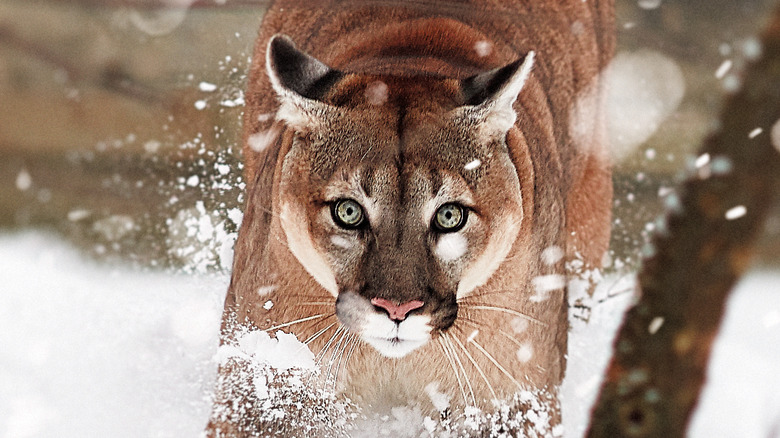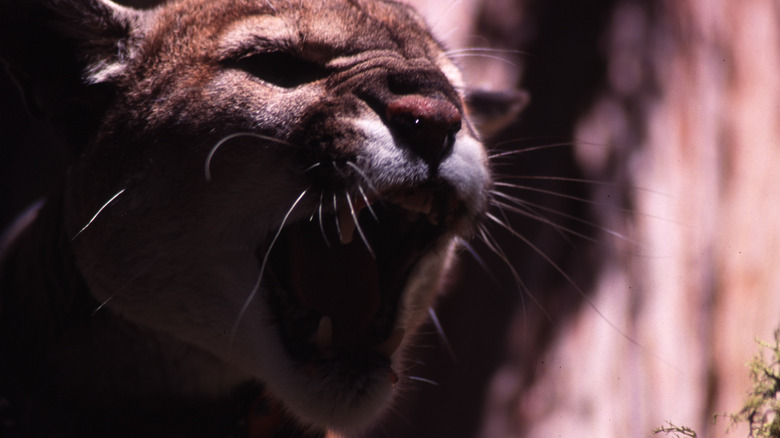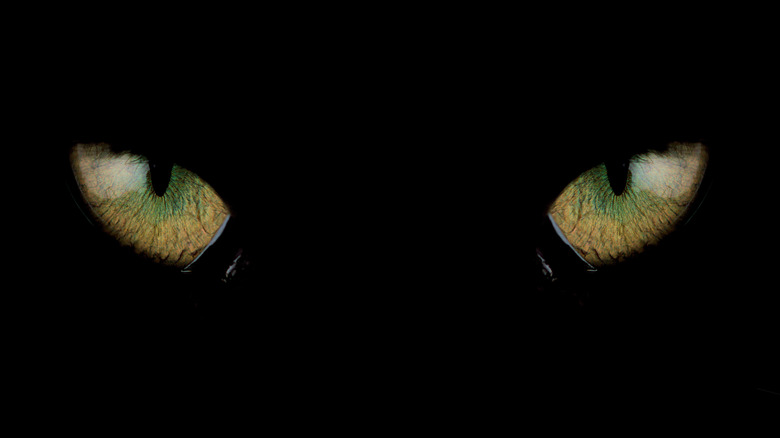What Are Ghost Cats (And Why Do People Claim To See Them)?
All the world over, there are reports of big cats living where no big cats should be. Rumors and sightings persist of oversized black cats in the British countryside (per Pacific Standard magazine). Australia has the Lithgow or Blue Mountains Panther (per the Australian Broadcasting Corporation). And ghost cats are still said to haunt the eastern part of the United States.
"Ghost" in this case doesn't refer to a supernatural entity, but rather an extremely elusive big cat, a puma. Or cougar, if you prefer. Catamount is accepted too, as is panther, and mountain lion. Despite its size, the cougar isn't considered a member of the big cat genus Panthera (its genus name is Puma) and is more closely related to the cheetah (per the Cheetah Conservation Fund Canada). Once ubiquitous throughout the Americas, the cougar's natural range has been eroded through hunting and territory and game loss, and they are now believed to live exclusively from the east side of the Rocky Mountains spanning out across the west, except for a small Florida population.
Yet every year, according to JSTOR, reports come in from east of the Mississippi that cougars still roam the land. Since the 1950s, thousands of eyewitnesses have claimed encounters with these ghost cats. What's more, some of these sightings have been verified. A cougar from South Dakota made his way through Wisconsin into Connecticut before being hit by a car in 2011, and photos captured a possible puma prowling around Lehigh County in Pennsylvania in 2023 per the Miami Herald.
Skeptics dismiss ghost cat sightings as unreliable
While a few pumas east of the Mississippi have been positively identified, skeptics cast doubt on any substantial eastern population of cougars outside the Florida panther's range since 1938, when the last Eastern cougar was killed according to the Miami Herald. Biologist James E. Cardoza hasn't been shy about his doubts, in published research and in comments to JSTOR. There may be a romantic yearning for cougars, a symbol of the American wilderness, to still be living across the country, but there just isn't much hard evidence, like a corpse from a dead animal. Only around 15 such bodies have been found since 1950, most of them escaped pets or other captive animals.
Eyewitnesses who've had a ghost cat encounter insist that the cougars are out there, and pushback from skeptics can only entrench their position. Cardoza maintains that many ghost cat sightings are misidentifications of smaller cats, coyotes, and even dogs. He also notes longstanding issues with eyewitness testimony: bias (conscious or unconscious) and memory issues.
The limits of eyewitness testimony have implications beyond tracking possible big cats in the Eastern U.S.; Teach Democracy has raised issues with such testimony in courts, and Science has reported on studies that focus on its limitations. But it is worth noting that other studies indicate memory is easily influenced but not unreliable, and that proper procedure can get accurate answers, whether about a crime scene or a ghost cat (per Scientific American).
There's another ghost cat legend in the eastern United States
Those who have seen cougars in Pennsylvania, Wisconsin, Connecticut, and other parts of the Eastern United States may dig their heels in the same way UFO enthusiasts due when faced with skepticism, but they aren't claiming any paranormal activity. The "ghost cats" they claim to have seen aren't taken as the spirits of hunted pumas who once roamed the land; they're taken as living, breathing, hunting felines back in their old territory. But in the very heart of the United States, in its capital city, there are cat legends of a darker variety.
Per the White House Historical Association, one of the most notorious ghost stories of Washington D.C. concerns the Demon Cat, first reported during the Civil War. Sometimes a black cat, at other times a tabby, the Demon Cat (or D.C., as it's sometimes known) appears at random in different federal buildings to foretell disaster or frighten the unwary. This phantom is said to be a shapeshifter that begins as an ordinary housecat and grows well beyond puma size. One account from 1898 claimed that D.C. reached the size of an elephant.
That cats once had the run of passageways connecting government buildings is undeniable; they were the city's rat-catching service. Frightening nighttime encounters with cats and their glowing eyes could have sparked some rumors. As for the ghost cat — cougars did once live on the Potomac — and all over the U.S. for that matter (per the Wildlife Science Center), but the odds they've escaped detection in the streets of the nation's capital to inspire demonic tales are slim.


